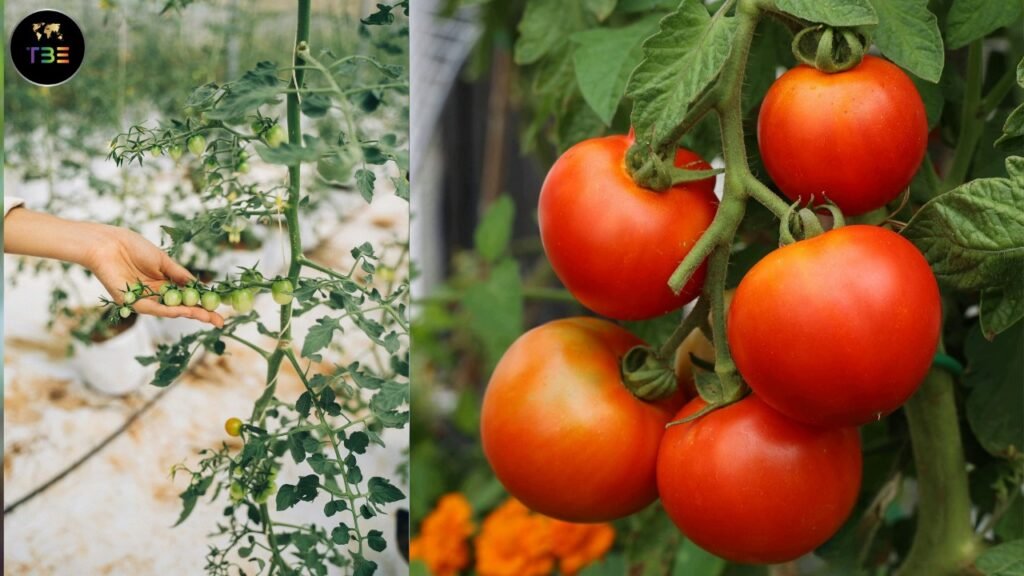
Have you ever planted a tomato seedling with fantastic expectation only to see its fruit fall or its leaves turn yellow as summer heat hits? Many of us think that growing tomatoes is as easy as picking one up from the local nursery, but actually, it takes patience, care, and knowledge to produce a good harvest. To grow a perfect tomato crop, one must skillfully combine insect prevention, water management, and great attention to detail.
This complete manual will cover everything from fertilizer selection to cutting processes to help you grow the healthiest, tastiest tomatoes yet.
Why Tomatoes Struggle: Common Problems and Solutions
Essentially climate tolerant, tomato plants may face many challenges, particularly for beginner growers. Poor water management, unhealthy soil, or lack of care are frequently the root causes of many different plant problems, such as yellowing leaves, cracked fruit, or poor growth. In order to avoid these problems and guarantee a common crop, it is essential to understand them.
- Learn how to Control Being wet with Mulching
Soil that is constantly wet is ideal for tomato growth. While overwatering can result in fungal diseases, fruit cracking, and root rot, too little water can cause wilting and weak growth. It’s important to strike this balance.
Covering the soil with plastic, wood chips, or straw to keep it continuously moist. Mulch protects the soil from intense rains and helps hold onto moisture during dry spells, lowering the possibility of wet roots. To avoid rot and enable efficient watering, apply a 2- to 3-inch thick layer of mulch, but keep it slightly away from the stem.
Tip: To avoid overwatering and keep the roots from drying out too soon when growing tomatoes in containers, set a saucer below the pot.
- Cutting to Reach The greatest Production
trimming may seem strange because, after all, photosynthesis requires as many leaves on a plant as possible. That is partially accurate, but excessive foliage can also decrease fruit yield and make fruits more open to disease. Stronger plants and healthier fruit are encouraged by trimming correctly.
- Start Early: Pulling off the first few blooms as soon as your tomato plant starts to bloom. Although this might postpone the first fruiting, it compels the plant to grow a strong root system, which eventually yields more tomatoes.
- Eliminate Suckers: As the plant develops, tiny shoots known as “suckers” will appear in the spaces between the main stem and the branches. Removal of these shoots on a regular basis is important because they can deplete fruit production of energy.
- Rreducing the plant to a maximum of three main stalks. As a result, the plant may concentrate its energy on resulting in smaller, better-quality tomatoes.
- Cut down Low Leaves: To increase air circulation and lower the risk of soil-borne fungal infections, remove leaves that are less than a foot above the ground.
- Provide Your Plants their Correct Nutrients: The Benefit of Fish Emulsion
Since tomatoes are heavy feeders, they need an abundance of nutrients to develop healthily. Your harvest can be made or broken by fertilization. Fish emulsion, a powerful mixture high in potassium, phosphorus, and nitrogen the three essential nutrients tomatoes love.
- Why Is Fish Emulsion Used? Fish emulsion provides a natural nutrient balance that provides your plants and enriches the soil, in contrast to chemical fertilizers. Potassium increases fruit size and flavor, phosphorus strengthens roots, and nitrogen encourages the growth of leaves. It’s an organic, sustainable choice that benefits the environment as well as your tomatoes.
- How to Apply: Every three weeks, mix fish emulsion with water according to the instructions on the package and apply it to the soil. You can apply the mixture to the leaves as a foliar feed to give the plant an extra boost and speed up its absorption of nutrients.
- Stakes vs. Cages for Tomato Plant Support
Particularly with unknown breeds, tomato plants can get tall and impossible to control. By keeping the fruit off the ground and using stakes or cages to support it, you can avoid rot and attract pests.
- Stakes: Plant a stake close to the plant and secure the growing stems to it. This is a simple and affordable solution, but in order to keep the plant upright, regular maintenance is needed.
- Cages: Compared to stakes, tomato cages offer more all-around support and require less maintenance. They keep the plant contained and shield it from wind damage while allowing it to grow naturally.
Tip: When the plant is big and heavy, always put in cages or stakes early to prevent damaging the roots later.
- Watering Carefully: Reliability Is Important
Plants that receive regular moisture thrive. Infrequent watering can result in fruit cracking, blossom-end rot, and lower yield. It’s especially important to let the plant dry out in between waterings.
- When to Water: When the sun isn’t too strong, early morning or late afternoon are the best times to water your tomatoes. This keeps the water from vaporizing too quickly and gives the roots enough time to absorb it.
- Avoid Overwatering: Tomatoes hate being soaked in water. Deeply but carefully water to avoid root rot. By providing moisture to the roots directly without soaking the leaves, a soaker hose or drip irrigation system lowers the chance of fungal infections.
- Dealing with Insects and Diseases: Prevention and Control
Many diseases and insects can affect tomatoes. While destroys, leaf spots, and wilts can harm entire crops, aphids, tomato hornworms, and whiteflies can quickly infest plants.
- Pest Control: Make routine checks for pests on your plants. For minor diseases, natural solutions like insect-fighting soap or neem oil work well. The best method for larger insects, like hornworms, is frequently picking by hand.
- Disease Prevention: Wet, poorly ventilated environments are ideal for the growth of fungi, such as blight. Improve airflow by trimming your plants, keep foliage off the ground by supporting them with stakes or cages, and stay away from watering the leaves. When a plant shows symptoms of infection, remove the affected parts right away.
ALSO READ: The Hidden Dangers of Ultra-Processed Foods: Why They’re Worse Than You Think










Leave a Reply